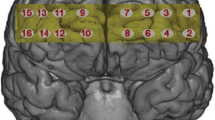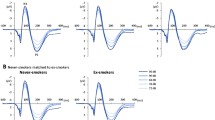Abstract
Rationale
There is important preclinical evidence of the long-lasting neurotoxic and selective effects of ecstasy (MDMA) on serotonin systems in nonhuman primates. In humans, long-term recreational use of ecstasy has been mainly associated with memory impairment.
Objective
The first aim of our study was to evaluate the cognitive and electrophysiological long-term alterations associated with lifetime ecstasy use within a sample of ecstasy polydrug users along a 1-year follow-up. Our second aim was to explore the relationship between specific cognitive functions and P300 (P3) event-related potentials (ERPs) in ecstasy users.
Materials and methods
We conducted auditory P3 latency and amplitude and administered a battery of cognitive tests to three groups of subjects: 14 current ecstasy polydrug users, 13 current cannabis users, and 22 controls free of illicit drugs in two evaluations during 1 year.
Results
We found significant differences between ecstasy users and controls on cognitive measures of word fluency, processing speed, and memory recognition after 1-year follow-up. We found no significant differences between ecstasy and cannabis users or cannabis users and controls on cognitive tests. Lifetime ecstasy use was associated with poorer memory recognition. No group differences were shown on P3 latency or amplitude. Significant correlations emerged between P3 latency and cannabis lifetime use (higher cannabis use was related to faster latency, showing a paradoxical effect) but not with ecstasy exposure.
Conclusions
Our findings provide evidence of mild long-term cognitive deficits among ecstasy polydrug users. Both ecstasy use and the dynamic interaction between ecstasy and cannabis effects may account for these deficits. No significant P3 alterations were found in ecstasy users.
Similar content being viewed by others
References
Baldo JV, Schwartz S, Wilkins D, Dronkers NF (2006) Role of frontal versus temporal cortex in verbal fluency as revealed by voxel-based lesion symptom mapping. J Int Neuropsychol Soc 12:896–900
Benton AL, Hamsher K deS (1976) Multilingual Aphasia Examination: Manual of instruction. Iowa City: University of Iowa
Casco C, Forcella M, Beretta G, Grieco A, Campana G (2005) Long-term effects of MDMA (ecstasy) on the human central nervous system revealed by visual evoked potentials. Addict Biol 10:187–195
Croft RJ, Klugman A, Baldeweg T, Gruzelier JG (2001a) Electrophysiological evidence of serotonergic impairment in long-term MDMA (“Ecstasy”) users. Am J Psychiatr 158:1687–1692
Croft RJ, Mackay AJ, Mills AT, Gruzelier JG (2001b) The relative contributions of ecstasy and cannabis to cognitive impairment. Psychopharmacology 153:373–379
Daumann J, Till B, Fischermann T, Rezk M, Gouzoulis-Mayfrank E (2006) Intensity dependence of auditory evoked dipole source activity in polydrug ecstasy users: evidence from an 18 months longitudinal study. J Psychopharmacol 20:236–244
de la Torre R, Farre M (2004) Neurotoxicity of MDMA (ecstasy): the limitations of scaling from animals to humans. Trends Pharmacol Sci 25:505–508
Delis DC, Kramer JH, Kaplan E, Ober BA (2000) California Verbal Learning Test-Second Edition (CVLT-II). San Antonio: Psychological Corporation
European Monitoring Centre for Drugs and Drug Addiction (2007) OEDT Annual Report- The State of the Drugs Problem in Europe, pp. 48–55
Fox HC, McLean A, Turner JJ, Parrott AC, Rogers R, Sahakian BJ (2002) Neuropsychological evidence of a relatively selective profile of temporal dysfunction in drug-free MDMA (“ecstasy”) polydrug users. Psychopharmacology 162:203–214
Gamma A, Brandeis D, Brandeis R, Vollenweider FX (2005) The P3 in ‘ecstasy’ polydrug users during response inhibition and execution. J Psychopharmacol 19:504–512
Gouzoulis-Mayfrank E, Daumann J (2006) Neurotoxicity of methylenedioxyamphetamines (MDMA; ecstasy) in humans: how strong is the evidence for persistent brain damage? Addiction 101:348–361
Gouzoulis-Mayfrank E, Fischermann T, Rezk M, Thimm B, Hensen G, Daumann J (2005) Memory performance in polyvalent MDMA (ecstasy) users who continue or discontinue MDMA use. Drug Alcohol Depend 78:317–323
Green AR, Mechan AO, Elliott JM, O’Shea E, Colado MI (2003) The pharmacology and clinical pharmacology of 3,4-methylenedioxymethamphetamine (MDMA, “ecstasy”). Pharmacol Rev 55:463–508
Fisk JE, Montgomery C, Wareing M, Murphy PN (2005) Reasoning deficits in ecstasy (MDMA) polydrug users. Psychopharmacology 181:550–559
Hansell NK, Wright MJ, Luciano M, Geffen GM, Geffen LB, Martin NG (2005) Genetic covariation between event-related potential (ERP) and behavioral non-ERP measures of working-memory, processing speed, and IQ. Behav Genet 35:695–706
Hansenne M (2000) The p300 cognitive event-related potential. I. theoretical and psychobiologic perspectives. Neurophysiol Clin 30:191–210
Hatzidimitriou G, McCann UD, Ricaurte GA (1999) Altered serotonin innervation patterns in the forebrain of monkeys treated with (+/−)3,4-methylenedioxymethamphetamine seven years previously: factors influencing abnormal recovery. J Neurosci 19:5096–5107
Horn H, Syed N, Lanfermann H, Maurer K, Dierks T (2003) Cerebral networks linked to the event-related potential P300. Eur Arch Psychiatry Clin Neurosci 253:154–159
Hothorn T, Bretz F, Westfall P with contributions by Richard M. Heiberger (2007) multcomp: simultaneous inference for general linear hypotheses. R package version 0.992-6.
Iacono WG, McGue M (2006) Association between P3 event-related brain potential amplitude and adolescent problem behavior. Psychophysiology 43:465–469
Iacono WG, Carlson SR, Malone SM, McGue M (2002) P3 event-related potential amplitude and the risk for disinhibitory disorders in adolescent boys. Arch Gen Psychiatry 59:750–757
Kalechstein AD, De La Garza R 2nd, Mahoney JJ 3rd, Fantegrossi WE, Newton TF (2007) MDMA use and neurocognition: a meta-analytic review. Psychopharmacology 189:531–537
Knott V, Millar A, Dulude L, Bradford L, Alwahhabi F, Lau T, Shea C, Wiens A (2004) Event-related potentials in young and elderly adults during a visual spatial working memory task. Clin EEG Neurosci 35:185–192
Lamers CT, Bechara A, Rizzo M, Ramaekers JG (2006) Cognitive function and mood in MDMA/THC users, THC users and non-drug using controls. J Psychopharmacol 20:302–311
Linden DE (2005) The p300: where in the brain is it produced and what does it tell us? Neurosci 11:563–576
Lyles J, Cadet JL (2003) Methylenedioxymethamphetamine (MDMA, ecstasy) neurotoxicity: cellular and molecular mechanisms. Brain Res Brain Res Rev 42:155–168
McCann UD, Szabo Z, Seckin E, Rosenblatt P, Mathews WB, Ravert HT, Dannals RF, Ricaurte GA (2005) Quantitative PET studies of the serotonin transporter in MDMA users and controls using [11C]McN5652 and [11C]DASB. Neuropsychopharmacology 30:1741–1750
Mejias S, Rossignol M, Debatisse D, Streel E, Servais L, Guerit JM, Philippot P, Campanella S (2005) Event-related potentials (ERPs) in ecstasy (MDMA) users during a visual oddball task. Biol Psychol 69:333–352
Miller EN (1990) California Computerized Assessment Battery (CalCAP): Manual. Los Angeles: Norland Software
Montgomery C, Fisk JE, Newcombe R, Murphy PN (2005) The differential effects of ecstasy/polydrug use on executive components: shifting, inhibition, updating and access to semantic memory. Psychopharmacology 182:262–276
Morgan MJ (2000) Ecstasy (MDMA): a review of its possible persistent psychological effects. Psychopharmacology 152:230–248
Nebel K, Wiese H, Stude P, de Greiff A, Diener HC, Keidel M (2005) On the neural basis of focused and divided attention. Brain Res Cogn Brain Res 25:760–776
Parrott AC (2006) MDMA in humans: factors which affect the neuropsychobiological profiles of recreational ecstasy users, the integrative role of bioenergetic stress. J Psychopharmacol 20:147–163
Parrott AC, Rodgers J, Buchanan T, Ling J, Heffernan T, Scholey AB (2006) Dancing hot on Ecstasy: physical activity and thermal comfort ratings are associated with the memory and other psychobiological problems reported by recreational MDMA users. Hum Psychopharmacol 21:285–298
Parrott AC, Milani RM, Gouzoulis-Mayfrank E, Daumann J (2007) Cannabis and ecstasy/MDMA (3,4-methylenedioxymethamphetamine): an analysis of their neuropsychobiological interactions in recreational users. J Neural Transm 114:959–968
Pichini S, Poudevida S, Pujadas M, Menoyo E, Pacifici R, Farré M, de la Torre R (2006) Assessment of chronic exposure to MDMA in a group of consumers by segmental hair analysis. Ther Drug Monit 28:106–109
Pinheiro J, Bates D, DebRoy S, Sarkar D the R Core team (2007) nlme: linear and nonlinear mixed effects models. R package version 3.1-86
Polich J (2007) Updating P300: an integrative theory of P3a and P3b. Clin Neurophysiol 118:2128–2148
Polich J, Criado JR (2006) Neuropsychology and neuropharmacology of P3a and P3b. Int J Psychophysiol 60:172–185
Pujadas M, Pichini S, Poudevida S, Menoyo E, Zuccaro P, Farré M, de la Torre R (2003) Development and validation of a gas chromatography-mass spectrometry assay for hair analysis of amphetamine, methamphetamine and methylenedioxy derivatives. J Chromatogr B Analyt Technol Biomed Life Sci 798:249–255
Quednow BB, Jessen F, Kuhn KU, Maier W, Daum I, Wagner M (2006) Memory deficits in abstinent MDMA (ecstasy) users: neuropsychological evidence of frontal dysfunction. J Psychopharmacol 20:373–384
Ramier AM, Hécaen H (1970) Rôle respectif des atteintes frontales et de la latéralisation lésionnelle dans les déficits de la fluence verbale. Revue Neurologique 123:17–22
Reneman L, Schilt T, de Win MM, Booij J, Schmand B, van den Brink W, Bakker O (2006) Memory function and serotonin transporter promoter gene polymorphism in ecstasy (MDMA) users. J Psychopharmacol 20:389–399
Rey A (1941) L´examen psychologique dans le cas d´encéphalopathie traumatique. Archives de Psychologie 28:286–340
Rey A (1959) Test de copie et de reproduction de mémoire de figures géométriques complexes. Les éditions du Centre de Psychologie appliqué. Paris
Rodgers J, Buchanan T, Scholey AB, Heffernan TM, Ling J, Parrott AC (2003) Patterns of drug use and the influence of gender on self-reports of memory ability in ecstasy users: a web-based study. J Psychopharmacol 17:389–396
Sala M, Braida D (2005) Endocannabinoids and 3,4-methylenedioxymethamphetamine (MDMA) interaction. Pharmacol Biochem Behav 81:407–416
Scheffel U, Szabo Z, Mathews WB, Finley PA, Dannals RF, Ravert HT, Szabo K, Yuan J, Ricaurte GA (1998) In vivo detection of short- and long-term MDMA neurotoxicity—a positron emission tomography study in the living baboon brain. Synapse 29:183–192
Shallice T (1982) Specific impairments of planning. Philosophical Transactions of the Royal Society of London 298:199–209
Smith A (1973) Symbol Digit Modalities Test (SDMT). Manual. Los Angeles: Western Psychological Services
Solowij N, Michie PT, Fox AM (1995) Differential impairments of selective attention due to frequency and duration of cannabis use. Biol Psychiatry 37:731–739
Thomasius R, Zaplova P, Petersen K, Buchert R, Andresen B, Wartberg L, Nebeling B, Schmoldt A (2006) Mood, cognition and serotonin transporter availability in current and former ecstasy (MDMA) users: the longitudinal perspective. J Psychopharmacol 20:211–225
Tuchtenhagen F, Daumann J, Norra C, Gobbelé R, Becker S, Pelz S, Sass H, Buchner H, Gouzoulis-Mayfrank E (2000) High intensity dependence of auditory evoked dipole source activity indicates decreased serotonergic activity in abstinent ecstasy (MDMA) users. Neuropsychopharmacology 22:608–617
United Nations Office on Drugs and Crime (UNODC) (2006) World Drug Report 1:143–152
Verheyden SL, Henry JA, Curran HV (2003) Acute, sub-acute and long-term subjective consequences of ‘ecstasy’ (MDMA) consumption in 430 regular users. Hum Psychopharmacol 18:507–517
Wager TD, Smith EE (2003) Neuroimaging studies of working memory: a meta-analysis. Cogn Affect Behav Neurosci 3:255–274
Wareing M, Fisk JE, Montgomery C, Murphy PN, Chandler MD (2007) Information processing speed in ecstasy (MDMA) users. Hum Psychopharmacol 22:81–88
Wechsler D (1977a) Wechsler Adult Intelligence Scale-III. San Antonio: The Psychological Corporation
Wechsler D (1977b) Wechsler Memory Scale. Third edition manual. San Antonio: The Psychological Corporation
Yoon HH, Iacono WG, Malone SM, McGue M (2006) Using the brain P300 response to identify novel phenotypes reflecting genetic vulnerability for adolescent substance misuse. Addict Behav 31:1067–1087
Zakzanis KK, Young DA (2001) Memory impairment in abstinent MDMA (“ecstasy”) users: a longitudinal investigation. Neurology 56:966–969
Zakzanis KK, Campbell Z (2006) Memory impairment in now abstinent MDMA users and continued users: a longitudinal follow-up. Neurology 66:740–741
Zakzanis KK, Campbell Z, Jovanovski D (2007) The neuropsychology of ecstasy (MDMA) use: a quantitative review. Hum Psychopharmacol 22:427–435
Acknowledgements
This study was supported in part by Fondo de Investigaciones Sanitarias (FIS-00/00777) and Plan Nacional Sobre Drogas (INT/2012/2002) Spain, the project “Neurotossicita’ a Lungo Termine dell’ Ecstasy” from Istituto Superiore di Sanità, Rome, Italy, and Generalitat de Catalunya (2001SGR00407, SGR 2005).
Conflict of interests
The authors declare the absence of conflicts of interest.
Author information
Authors and Affiliations
Corresponding author
Rights and permissions
About this article
Cite this article
de Sola, S., Tarancón, T., Peña-Casanova, J. et al. Auditory event-related potentials (P3) and cognitive performance in recreational ecstasy polydrug users: evidence from a 12-month longitudinal study. Psychopharmacology 200, 425–437 (2008). https://doi.org/10.1007/s00213-008-1217-5
Received:
Accepted:
Published:
Issue Date:
DOI: https://doi.org/10.1007/s00213-008-1217-5




